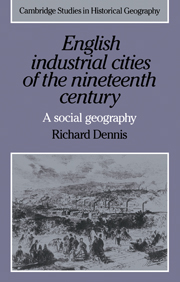Book contents
- Frontmatter
- Contents
- List of Figures
- List of Tables
- Preface
- A note on prices and distances
- 1 Urban geography and social history
- 2 Sources of diversity among Victorian cities
- 3 Contemporary accounts of nineteenth-century cities
- 4 Public transport and the journey to work
- 5 The geography of housing
- 6 Class consciousness and social stratification
- 7 The spatial structure of nineteenth-century cities
- 8 Residential mobility, persistence and community
- 9 Community and interaction
- 10 The containing context
- Notes
- Bibliography
- Index
3 - Contemporary accounts of nineteenth-century cities
Published online by Cambridge University Press: 05 January 2010
- Frontmatter
- Contents
- List of Figures
- List of Tables
- Preface
- A note on prices and distances
- 1 Urban geography and social history
- 2 Sources of diversity among Victorian cities
- 3 Contemporary accounts of nineteenth-century cities
- 4 Public transport and the journey to work
- 5 The geography of housing
- 6 Class consciousness and social stratification
- 7 The spatial structure of nineteenth-century cities
- 8 Residential mobility, persistence and community
- 9 Community and interaction
- 10 The containing context
- Notes
- Bibliography
- Index
Summary
Social observers in the first half of the nineteenth century had good reason to interest themselves in the geography of population and land use in their rapidly growing cities. At least two strands of argument can be discerned. Firstly, it was recognised that the geography of death and disease had an intra-urban as well as a rural-urban dimension. Chadwick's famous distinction between life expectancy in Manchester and Rutland was not the only geographical contrast worth making; there were equally dramatic differences in birth rates, death rates and average age at death between one part of Manchester and another. The apparently increasing scale of residential differentiation within cities - of rich and poor, English and Irish, sanitary and insanitary, cleansed and uncleansed - encouraged the identification of ecological correlations between mortality and fever rates on the one hand and housing and sanitary conditions on the other. Like all ecological correlations they were subject to varying interpretations: did the pig make the sty, or the sty make the pig? The authors of local reports to Chadwick's inquiry inclined to the view that poverty was the consequence of intemperance, waste, idleness and mismanagement, that disease resulted from filthy habits and moral degeneracy. Chadwick himself, reflecting his own position with the Poor Law Commission, was more concerned to demonstrate the economic costs of insanitary conditions: bad sanitation fostered disease and disease produced poverty, both by increasing the number of widows and orphans dependent upon poor rates, and by reducing the physical efficiency of workers suffering chronic ill health.
- Type
- Chapter
- Information
- English Industrial Cities of the Nineteenth CenturyA Social Geography, pp. 48 - 109Publisher: Cambridge University PressPrint publication year: 1984



